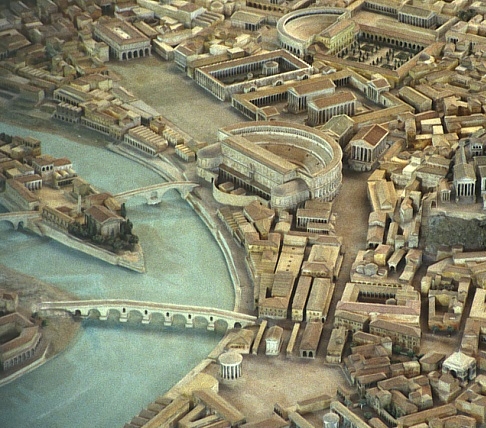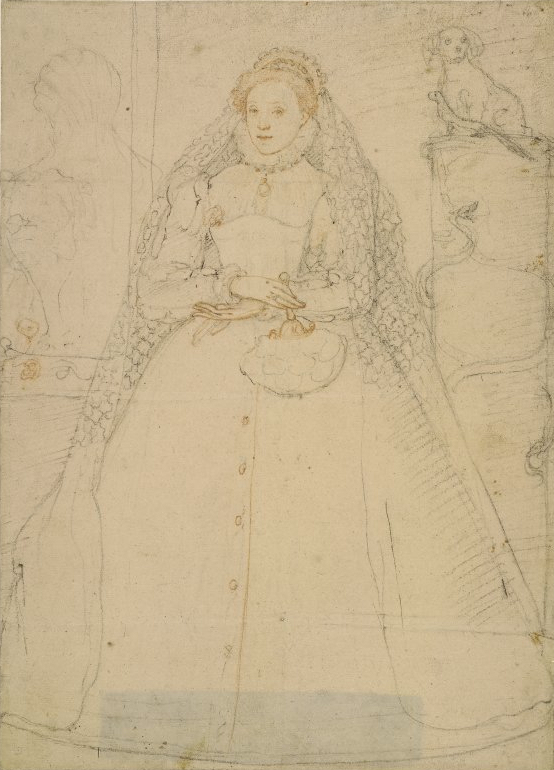|
Palazzo Mattei Caetani
The Palazzo Caetani, also known as the Palazzo Mattei Caetani, and once known as the Palazzo of Alessandro Mattei or the Palazzo Mattei alle Botteghe Oscure, is an urban palace located on via delle Botteghe Oscure #32 in the rione Sant'Angelo of Rome, Italy. A palace at the site was initially commissioned from the architect Nanni di Baccio Bigio between 1545 and 1564 by Alessandro Mattei; this structure was purchased in 1776, by the Caetani, and has undergone numerous refurbishments. The building contains a number of tenants, including the Brazilian embassy to the Vatican, but also houses the Fondazione Camillo Caetani, including its library. The interior decoration was begun by Alessandro Mattei, who employed the brothers Taddeo and Federico Zuccari in painting some of the works in the piano nobile. Cristoforo Roncalli painted the palace chapel, and collaborated with Paul Bril, to decorate some of the rooms. The Caetani family employed Antonio Cavallucci Antonio Cavallucci ... [...More Info...] [...Related Items...] OR: [Wikipedia] [Google] [Baidu] |
Palazzo Mattei Caetani
The Palazzo Caetani, also known as the Palazzo Mattei Caetani, and once known as the Palazzo of Alessandro Mattei or the Palazzo Mattei alle Botteghe Oscure, is an urban palace located on via delle Botteghe Oscure #32 in the rione Sant'Angelo of Rome, Italy. A palace at the site was initially commissioned from the architect Nanni di Baccio Bigio between 1545 and 1564 by Alessandro Mattei; this structure was purchased in 1776, by the Caetani, and has undergone numerous refurbishments. The building contains a number of tenants, including the Brazilian embassy to the Vatican, but also houses the Fondazione Camillo Caetani, including its library. The interior decoration was begun by Alessandro Mattei, who employed the brothers Taddeo and Federico Zuccari in painting some of the works in the piano nobile. Cristoforo Roncalli painted the palace chapel, and collaborated with Paul Bril, to decorate some of the rooms. The Caetani family employed Antonio Cavallucci Antonio Cavallucci ... [...More Info...] [...Related Items...] OR: [Wikipedia] [Google] [Baidu] |
Rione Sant'Angelo
Sant'Angelo is the 11th '' rione'' of Rome, Italy, located in Municipio I. Often written as ''rione XI - Sant'Angelo'', it has a coat of arms with an angel on a red background, holding a palm branch in its left hand. In another version, the angel holds a sword in its right hand and a scale in its left. Sant'Angelo, the smallest of Rome's rioni, lies along the Tiber river east of Tiber Island. Rioni bordering this district, clockwise from north to south, include Regola, Sant'Eustachio, Pigna, Campitelli, and Ripa. Sant'Angelo's western border is the river. The rione's terrain is low and flat and, until the construction of the Lungotevere, particularly susceptible to flooding from the river. The historical significance of Sant'Angelo is mainly the result of the presence here of the Roman Ghetto. History Roman Age: ''Circus Flaminius'' During the early Roman period, the territory occupied by Sant'Angelo lay outside the Servian walls, east of the island. Thi ... [...More Info...] [...Related Items...] OR: [Wikipedia] [Google] [Baidu] |
Rome
, established_title = Founded , established_date = 753 BC , founder = King Romulus (legendary) , image_map = Map of comune of Rome (metropolitan city of Capital Rome, region Lazio, Italy).svg , map_caption = The territory of the ''comune'' (''Roma Capitale'', in red) inside the Metropolitan City of Rome (''Città Metropolitana di Roma'', in yellow). The white spot in the centre is Vatican City. , pushpin_map = Italy#Europe , pushpin_map_caption = Location within Italy##Location within Europe , pushpin_relief = yes , coordinates = , coor_pinpoint = , subdivision_type = Country , subdivision_name = Italy , subdivision_type2 = Region , subdivision_name2 = Lazio , subdivision_type3 = Metropolitan city , subdivision_name3 = Rome Capital , government_footnotes= , government_type = Strong Mayor–Council , leader_title2 = Legislature , leader_name2 = Capitoline Assemb ... [...More Info...] [...Related Items...] OR: [Wikipedia] [Google] [Baidu] |
Federico Zuccari
Federico Zuccaro, also known as Federico Zuccari (c. 1540/1541August 6, 1609), was an Italian Mannerist painter and architect, active both in Italy and abroad. Biography Zuccaro was born at Sant'Angelo in Vado, near Urbino (Marche). His documented career as a painter began in 1550, when he moved to Rome to work under Taddeo, his elder brother. He went on to complete decorations for Pius IV, and help complete the fresco decorations at the Villa Farnese at Caprarola. Between 1563 and 1565, he was active in Venice with the Grimani family of Santa Maria Formosa. During his Venetian period, he traveled alongside Palladio in Friuli. He was involved in the following fresco projects: * Decoration of the Casina Pio IV, Rome * Grimani Chapel, San Francesco della Vigna, Venice *Monumental staircase, Palazzo Grimani, Venice * Pucci Chapel in the church of Trinità dei Monti, Rome * San Marcello al Corso, Rome * Cathedral of Orvieto (1570) * Oratorio del Gonfalone, Rome (1573) * ''The La ... [...More Info...] [...Related Items...] OR: [Wikipedia] [Google] [Baidu] |
Cristoforo Roncalli
Cristoforo Roncalli (c. 1552–1626) was an Italian mannerist painter. He was one of the three painters known as ''Pomarancio'' or ''Il Pomarancio''. Life Roncalli was born in Pomarance, a town near Volterra. His training occurred in Tuscany, and around 1578, he relocated to Rome, Italy where he worked for Niccolò Circignani (also known as ''il Pomarancio''). Most of his fresco work was in Rome, though he worked for a decade in Loreto (1605–1615), where he decorated the New Sacristy. In Rome he decorated the cupola of the church of Santa Maria di Loreto and of San Silvestro in Capite. He helped decorate ''Santa Maria in Vallicella'' for the Oratory of San Filippo Neri. He also painted for the Oratory of Santissimo Crocifisso, the ''Baptism of Constantine'' and ''St. Simon'' in the transept of San Giovanni in Laterano, and designed the mosaics in the ''Cappella Clementina'' in the St. Peter's Basilica. One of his pupils from Siena was Alessandro Casolano, an ... [...More Info...] [...Related Items...] OR: [Wikipedia] [Google] [Baidu] |
Paul Bril
Paul Bril (1554 – 7 October 1626) was a Flemish painter and printmaker principally known for his landscapes.Nicola Courtright. "Paul Bril." Grove Art Online. Oxford Art Online. Oxford University Press. Web. 26 September 2016 He spent most of his active career in Rome. His Italianate landscapes had a major influence on landscape painting in Italy and Northern Europe.Paul Bril, Landscape with Diana and Callisto at the Life [...More Info...] [...Related Items...] OR: [Wikipedia] [Google] [Baidu] |
Caetani
The House of Caetani, or Gaetani, is the name of an Italian noble family, originally from the city of Gaeta, connected by some to the lineage of the lords of the Duchy of Gaeta, as well as to the patrician Gaetani of the Republic of Pisa. It played an important role in Rome, in the Papal States and in the Kingdom of Naples, and later in the Kingdom of the Two Sicilies. Origins The Caetani, or Gaetani family, according to a family tradition, was descendant of the Dukes of Gaeta. Nevertheless, the family had no more great importance in Rome until the election of Benedetto Caetani to the papacy as Pope Boniface VIII in 1294, when they at once became the most notable in the city. The pope helped them to buy Sermoneta, Bassiano, Ninfa and San Donato (1297, 1300), and the marquisate of Ancona in 1300, while Charles II of Anjou created the pope's brother count of Caserta. Giordano Roffredo Caetani by his marriage with Giovanna dell'Aquila, heiress of the counts of Fondi, in 1297 acqui ... [...More Info...] [...Related Items...] OR: [Wikipedia] [Google] [Baidu] |
Antonio Cavallucci
Antonio Cavallucci (21 August 1752 – 18 November 1795) was an eighteenth-century Italian painter of religious scenes and portraits. Biography Cavallucci was born in Sermoneta in the Lazio. His artistic talents were recognized in an early stage by Francesco Caetani, Duke of Sermoneta in 1738-1810. In 1765, he brought the 13-year-old Cavallucci to Rome, where he became a pupil of Stefano Pozzi and three years later of Gaetano Lapis. by Giovanni Gherardo De Rossi; Venice 1796, page 13. He also studied drawing at the (c. 1769-1771). His earliest work dates from the mid-1760s. It is a |
Palaces In Rome
A palace is a grand residence, especially a royal residence, or the home of a head of state or some other high-ranking dignitary, such as a bishop or archbishop. The word is derived from the Latin name palātium, for Palatine Hill in Rome which housed the Roman Empire, Imperial residences. Most European languages have a version of the term (''palais'', ''palazzo'', ''palacio'', etc.), and many use it for a wider range of buildings than English. In many parts of Europe, the equivalent term is also applied to large private houses in cities, especially of the aristocracy; often the term for a large country house is different. Many historic palaces are now put to other uses such as parliaments, museums, hotels, or office buildings. The word is also sometimes used to describe a lavishly ornate building used for public entertainment or exhibitions such as a movie palace. A palace is distinguished from a castle while the latter clearly is fortified or has the style of a fortification ... [...More Info...] [...Related Items...] OR: [Wikipedia] [Google] [Baidu] |






